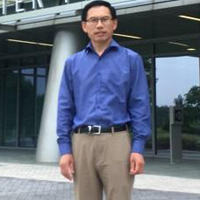Dr. Fanglin Yang
Location: College Park, MD
Office: NOAA’s Environmental Modeling Center, National Centers for Environmental Prediction
Job Title: Chief, Physics and Dynamics Division
Educational Background:
- Bachelor’s Degree in Meteorology from Chengdu Institute of Meteorology
- Master’s Degree in Atmospheric Physics from Chinese Academy of Sciences
- Doctorate in Atmospheric Sciences from University of Illinois at Urbana-Champaign
Describe the career path that led you to your current job with the National Weather Service.
- After graduating from University of Illinois, I worked at NOAA’s Climate Prediction Center for two years to develop seasonal climate prediction models and investigate seasonal climate variability. In 2002 I got transferred to NASA’s Climate and Radiation Laboratory to study the impact of black carbon and dust aerosols on monsoon prediction. Since 2004 I have been working at NOAA’s Environmental Modeling Center (EMC) to develop numerical weather prediction (NWP) models.
What do you do for the NWS?
- In my time at EMC I have worked on a variety of projects, including the transition of forecasting tools from research-to-operations, the development of sophisticated weather models, and science and technology integration for operational implementation. For the past 17 years, I have worked on the development and implementation of NOAA’s Global Forecast Systems (GFS) for weather prediction and led the transition of NOAA’s Next Generation Global Prediction System (NGGPS) into operations. NGGPS replaced the spectral dynamic core in GFS which had been in use until 2019 for NOAA operations for more than three decades. Currently I am leading the EMC’s model physics group to develop physics parameterizations for the Unified Forecast System (UFS) applications across different temporal and spatial scales and to prepare the transition for operations.
What was the most interesting, exciting, or impactful weather/water event you experienced while working for the NWS and why does it stand out?
- Hurricane Sandy was the most impactful weather event I experienced while working for NWS. It was the deadliest and most destructive hurricane of the 2012 Atlantic hurricane season, and one of the most costly hurricanes on record in the United States. I performed a set of experiments immediately after the event, discussed with EMC developers, and briefed out our understanding on how our systems predicted its path. It was an important time as we continue to work to find the very best modeling and forecasting tools to predict hurricane storm tracks as many days in advance as possible.
What made you decide to pursue a career with the NWS?
- My post-graduate research and my early professional career were focused on climate modeling and analysis. I worked at a few different institutions before I joined EMC to work on NWP model development. After seeing how important weather forecasting is for protecting life and property, and how difficult it is to make even tiny improvement in weather forecast accuracy, I became increasingly interested in the transition of research to operations to bring new science and technology forward to build better weather forecast models.
What do you like most about working for the NWS?
- The development and implementation of experimental forecast models into operations is the thing I have most enjoyed working on since I joined EMC. It is an intense process, requiring long hours of work and attention to the detail; however, there is also a feeling of fulfillment after each implementation, knowing that the new model is going to make the forecasts even more accurate. I also enjoy the challenges of the work and the collaboration and team spirit among my colleagues.
What advice do you have for someone interested in a career with the NWS?
- If you are interested in and studying science and technology, there may be a job for you at NWS. There are a variety of positions in different NWS offices across the county. Start as a summer intern if you are still in school, and if given the opportunity, explore different NWS research and operation centers and forecast offices in your early career to choose the best fit for you.
What training or coursework would you recommend to someone interested in following your career path?
- Weather forecasting and climate modeling are becoming more and more sophisticated. It is a minimum requirement to have education and training in mathematics, physics, and computer science. To have good communication skills and a collaborative attitude is also crucial for success. It is important to keep yourself motivated and continue learning so you can take advantage of unexpected opportunities when they arise.
